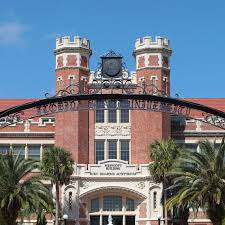Speaker
Description
The existence of a quasi-bound state of antikaon and nucleus, kaonic nucleus, has been discussed ever since the $\bar{K}N$ interaction in $I=0$ channel was confirmed to be strong attractive. The $\bar{K}NN$ quasi-bound state is the lightest kaonic nucleus which is considered to be $I=1/2$ and $J^\pi = 0^-$. To search for the $I_z=+1/2~\bar{K}NN$ state we conducted the J-PARC E15 experiment using in-flight $K^-$-beam at J-PARC.
Production of the $I_z=+1/2~\bar{K}NN$ state was examined by an exclusive analysis for a non-mesonic reaction, $K^-~^3{\rm He} \to \Lambda pn$, in which $\Lambda p$ pair is expected to be decay products of the $\bar{K}NN$. We observed a distinct peak in the $\Lambda p$ invariant mass spectrum at the energy region below the $\bar{K}+N+N$ mass threshold which can be naturally interpreted as a signal of $\bar{K}NN$ state.
As future prospects, there are two approaches to establish the kaonic nuclei more robustly. One is to search for heavier kaonic nuclei, and another is to study for the $\bar{K}NN$ state more precisely, especially for determination of spin and parity of the state. Thus, we have planned to perform series of experiments to study of kaonic nuclei using in-flight $K^-$ reaction at J-PARC. To perform future experiments, we will construct a new solenoid spectrometer system.
I would like to present the summary of J-PARC~E15 experiment and an overview of our future plan.
| speaker affiliation | RIKEN |
|---|

